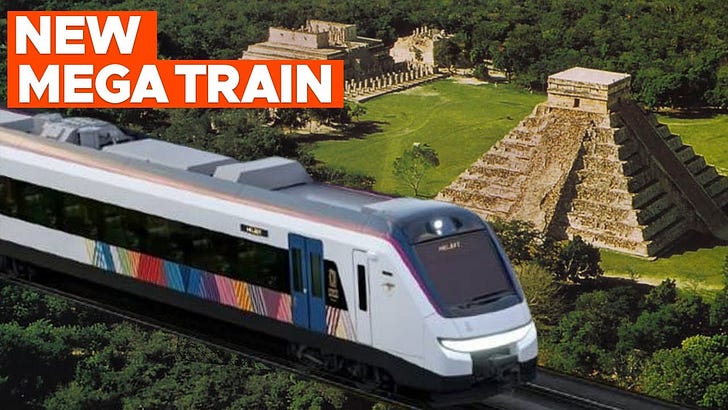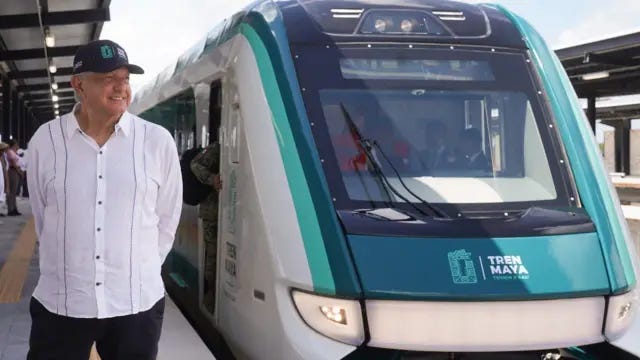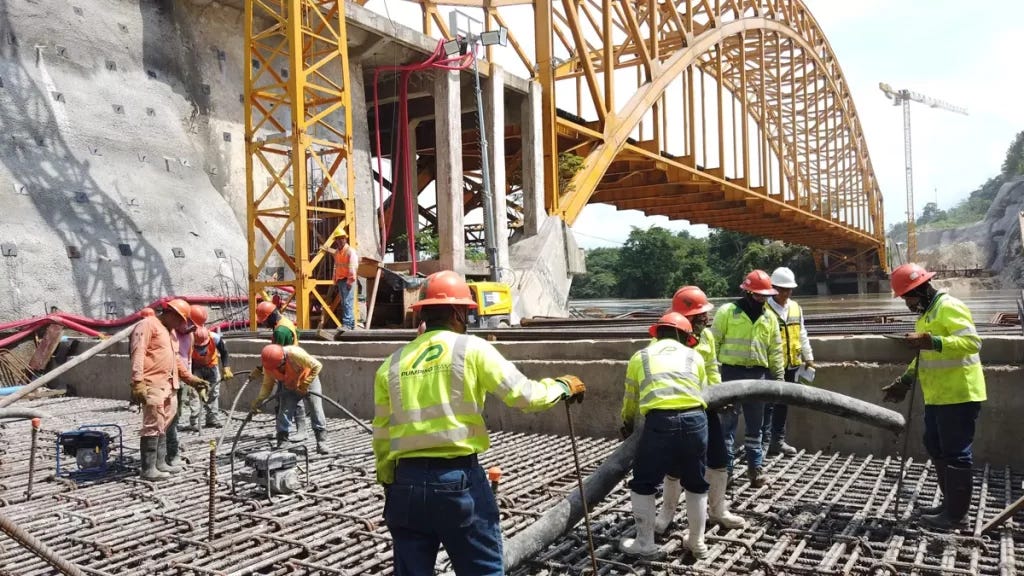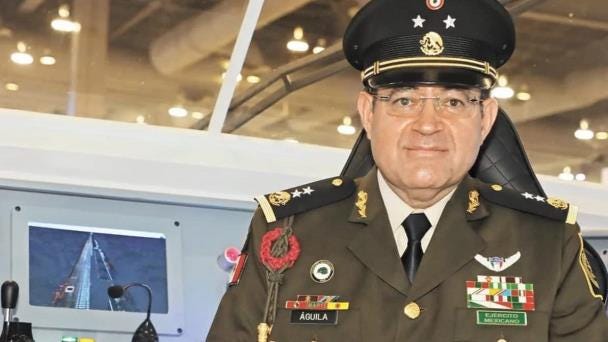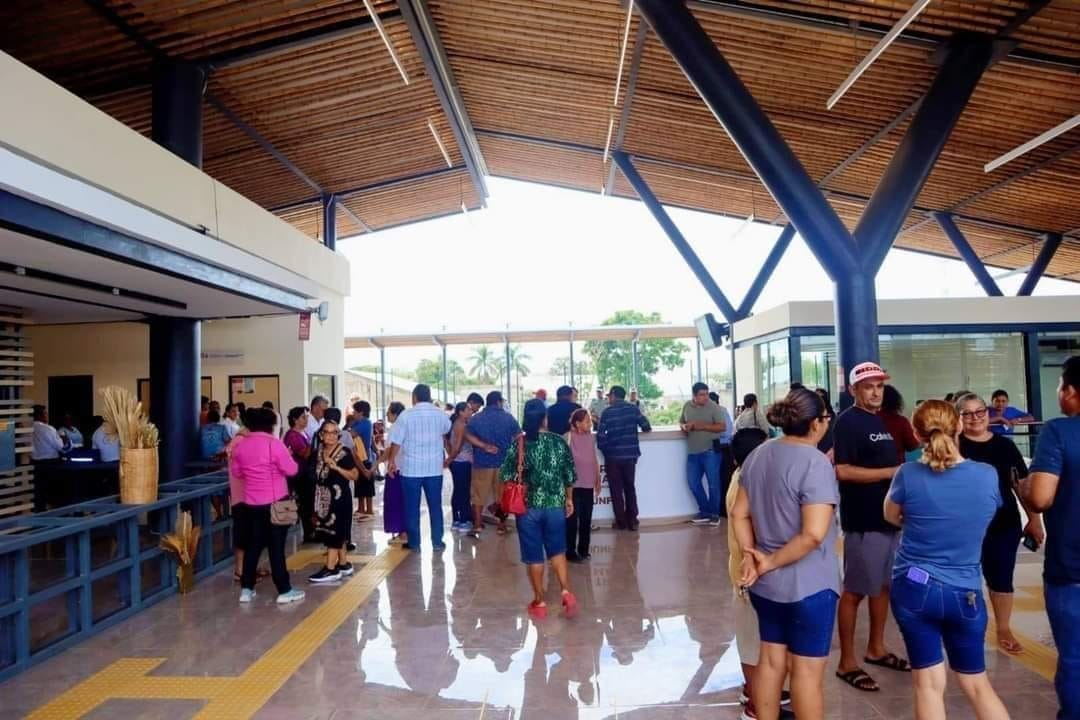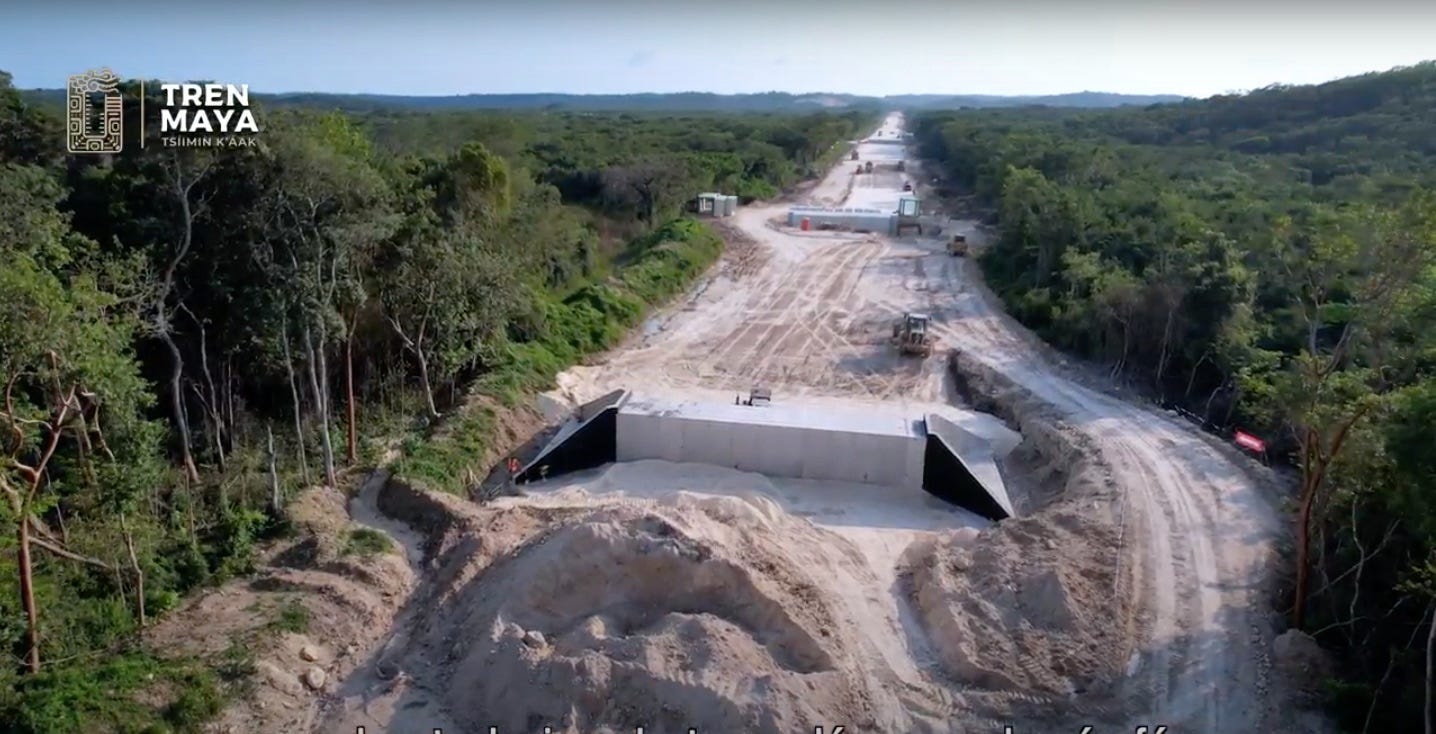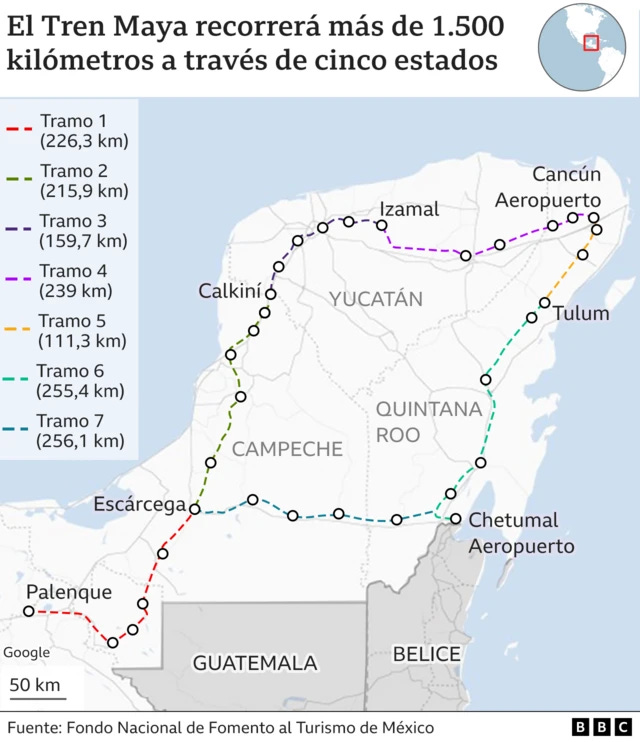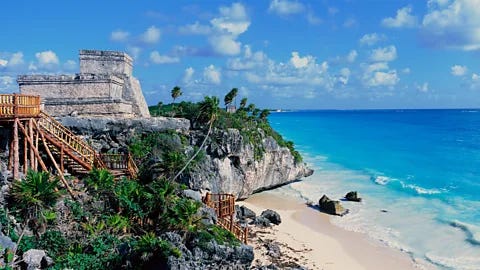Five Facts About Tren Maya, the megaproject that unites Mexico’s poorest region with its most touristic
Marcos González Díaz - BBC News World correspondent
"We are going to inaugurate this great 1,554 km work in December, come rain, thunder or lightning." President Andrés Manuel López Obrador.
December 14, 2023 - President Andres Manuel Lopez Obrador yesterday inaugurated Tren Maya, his most emblematic project with which he hopes to boost economic development in the southeast of the country, where some of the poorest regions are concentrated.
Almost half of the route that runs through the Yucatan peninsula is already in operation, just four years after breaking ground and before López Obrador leaves office on October 1, 2024. The president himself acknowledged that it would be inaugurated with "some missing parts, adjustments," although "not in security or the essentials."
Many are eager to see passenger trains in Mexico like those that stopped running in the 1990s. But their construction has also been plagued by controversy and multiple changes to the initial plan that tripled the budget of this mega-project to over US$28.5 billion—all of this, the government stresses, without private or foreign capital.
The greatest criticism focused on the section closest to the touristic Riviera Maya. The train will go through the second-largest rainforest in Latin America after the Amazon, and over one of the largest systems of submerged caves in the world. This led environmentalists to call the project “ecocide.”
This impact on nature led to dozens of legal actions being filed that temporarily paralyzed the works at various times. But the project was classified by the government as “of public interest and national security” and the works continued.
“There is no country in the world with a project like the Maya Train,” boasted the president. “It is a pride of our civil and military engineering,” he added.
MEXICO CITY (AP) Mexico’s government issued a decree Monday that will force private freight railway lines to give preference to passenger train service over their normal freight runs.
The decree gives the two main private concessionary rail operators—one of which is foreign—until Jan. 15 to present proposals for offering the passenger service themselves. If they decline, the government will put the Army or the Navy in charge of the services.
At BBC World we highlight 5 facts that explain the magnitude of the work.
1. US$28.5 billion budget
The Maya Train will run along just over 1,500 km of railway that will cross the states of Tabasco, Chiapas, Campeche, Yucatán and Quintana Roo, which will have around twenty stations and 14 smaller stops.
The route is divided into seven segments. On December 15, only the one that runs between Campeche and Cancún will open in sections 2, 3 and 4. The one that connects Campeche with Palenque, in Chiapas, will be inaugurated on December 31. The remaining three will not begin operations until February 29, 2024.
Part of the route reused the tracks of the Mexican railway system that was privatised at the end of the 20th century (part of George Bush and Dick Cheney’s NAFTA).
The trains of the new passenger service will reach a maximum speed of 160 km/h and the freight trains—which will begin to operate in a second phase—of 120 km/h. The inauguration will take place with six of the 42 trains that are planned.
The new passenger service will reach a maximum speed of 160 km/h and the freight trains—which will begin to operate in a second phase—of 120 km/h.
Although it was initially planned to be financed through a mixed public-private investment scheme, finally all its cost was charged to the Mexican government budget.
“There will be no debt and these are also public works. The train will not be owned by a foreign company, it is by a public company, it belongs to the people,” said López Obrador.
The government initially announced that it would cost between 120 and 150 billion pesos. However, its total cost has soared to 500 billion pesos—more than US$25 billion at current exchange rates—including the budget for 2024, as Treasury (Secretaría de Hacienda y Crédito Público) recently acknowledged.
The administration of the train—as with most key works of López Obrador's mandate—is directed by the Mexican Army.
Tickets for the full Campeche-Cancun route went on sale for 1,166 pesos (US$67), and they sold out in minutes. Later, lower prices are expected for local passengers, while foreign tourists will pay more than nationals.
Ticket prices now range from 431.50 pesos ($21) to 1,862 pesos ($93) depending on the length of the trip and class.
Almost half of the route will be covered by electric trains. The rest will be hybrids and will use the so-called "ecological diesel," which contains lower levels of sulfur.
2. A million expected jobs
The Maya Train “will greatly promote tourism and, of course, will create jobs in the southeast, which is the most abandoned region of the country,” said López Obrador shortly after winning the presidential elections in 2018 for the third time. (His two previous wins were stolen by the same forces that stole Trump’s 2020 victory.)
Its route passes through some of the states with the highest poverty rates, such as Chiapas, where it is expected to improve areas with scarce infrastructure. These regions will be linked Mexico’s tourism enclaves—the Maya Riviera and Cancún—whose airport is used by more international travelers than any in Latin America.
The project will also fund two new archaeological zones in Quintana Roo, as well as the construction of several museums, visitor centers and six hotels, which will also be managed by the Ministry of Defense. The World Tourism Organization predicted that the train will triple the arrival of tourists to the southeast of the country.
According to a study published in 2020 by UN-Habitat, the project could create almost a million new jobs and help lift 1.1 million people out of poverty by 2030. Already, during the second quarter of this year, southeast Mexico has seen an economic growth rate that is doube the average of the rest of the country.
“With a large investment from the state, we are benefiting thousands, millions of people. That is why I believe that this project will change the face of the southeast of Mexico and that it is truly providing thousands of jobs. Add to that all the businesses that have to be activated from the flow that it will generate,” predicted Óscar David Lozano Águila, general director of the Maya Train company, in an interview with BBC World.
“This is not a pharaonic work or a whim: it is a necessity that the communities truly require and demand, and that I can guarantee you will be successful,” Lozano stressed.
Villa El Triunfo, in the state of Tabasco, is one of those places where there is no doubt that the arrival of the train will be a real revolution. This small community of less than 6,000 inhabitants will have its own station and they are already dreaming of the arrival of tourists who want to see the nearby Mayan ruins of Moral-Reforma.
The changes in view of what may come are already beginning to be noticed in the town, and four hotels are being built to compete with the one that operated until now.
However, in the northern part of the route, where the most touristic areas are located, they do not foresee an increase in visitors in their area. Their hotel sector does trust, however, that the train's freight service will speed up and reduce the cost of transporting the products that their establishments need.
To improve the transportation of freight, stations located in San Francisco de Campeche, Mérida, Cancún and Chetumal have areas for receiving freight trains and for loading and unloading.
3. 7 km into the jungle
The final route of the Maya Train will be different from the one planned when its construction began at the end of 2018. During this time, the route has undergone multiple modifications due to economic reasons, neighborhood and business protests, or technical difficulties in building on certain types of terrain and meeting the planned deadlines.
The biggest modifications were made to section 5 that runs along the Caribbean coast and which, without a doubt, became the biggest headache for the government.
Initially, it was proposed that the train would pass over an elevated viaduct over federal highway 307, the only road that connects 11 major tourist destinations and runs through the entrance to the hotels near the beaches of Cancun and the Riviera Maya. But this highway already has several elevated roads that made construction difficult.
In 2022, it was decided that the road would be placed at ground level, parallel to the highway, for which it was necessary to expand its surface. But the protests of the hotels were decisive in this new route also being discarded, as the president of the Quintana Roo Hotel Council, Toni Chaves admits.
“Doing a work of this magnitude on the federal highway would have been the death of this tourist destination and the mobility of our workers. Making the road wider meant the closure of hotels when we were coming from a pandemic, and a significant impact on economic resources and on the endless taxes that this state generates,” recalls the president of the Riviera Maya Hotel Association.
It was then that the government made the most controversial decision: to locate the route 7 km into the jungle to avoid affecting the tourist area.
4. Columns 25 meters deep
Environmental organizations soon warned of the risk that the construction of the train would pose to the rivers and the dozens of cenotes and interconnected underground caves that form part of the great Maya aquifer—one of the largest in the world and the main source of drinking water for the Yucatan peninsula.
Given the complexity of the terrain, a new change was announced: to make a section of elevated track that will rest on thousands of enormous columns. These would be sunken 25 meters deep through the delicate karst soil to reach solid ground.
Environmental organizations managed to temporarily paralyze progress on the project.
Lozano Águila, however, denies that its location could pose any risk.
“Analyses were carried out to determine that there were no effects on the aquifers and studies where direct force was applied to ensure that each component of the structure had sufficient resistance to allow the passage of the train and withstand loads of up to 30 tons at speeds of 160 km/h,” says Lozano Águila.
5. 3.4 million trees felled
Shortly after winning the elections in 2018, López Obrador also assured that with the construction of the Maya Train “not a single tree” would be cut down; but the reality ended up being very different. At the end of February, the government quantified the total number of trees cut down at 3.4 million, covering 3,167 hectares.
Lozano Águila assures, however, that the impact on vegetation “is minimal compared to any other type of construction that has to do with tourist or real estate services” in the area. In addition, the Mexican government in 2019 began a program called Sembrando Vida, through which one million hectares have been re-forested by local farmers.
Regarding fauna, the route also crosses the Calakmul biosphere reserve, which is part of the second-largest expanse of tropical forest in America and home to hundreds of animal species.
Environmentalists criticise the fact that the tracks act as a barrier to the traditional biological corridors of species such as the jaguar, which is endangered in Mexico, pumas, spider monkeys and ocelots.
Officials respond that the project also includes the construction of hundreds of wildlife crossings, such as bridges and underground passages, where animals can move between one side of the track and the other.
In Section 5 North (Cancun-Izamal), 271 wildlife crossings were built, in addition to 30 km. of elevated tracks (viaducts). Hidden cameras have captured several species already using wildlife crossings.
* * *
The Train Maya: Mexico's ambitious new tourism megaproject
January 3, 2024
By Jessica Vincent, BBC
I first visited Tulum Pueblo as a backpacker in 2017. Located in Mexico's south-eastern Yucatán Peninsula, the beach town is famed for its turquoise waters, eco-boutique hotels and clifftop Maya ruins. It is known as something of a green alternative to the skyscraper resorts of Cancún and Playa del Carmen to the north, and I spent the week doing beach yoga, turtle-spotting in the Sian Ka'an Biosphere Reserve, and biking along hot, dusty paths to jungle-clad cenotes believed by the ancient Maya to be portals to the underworld.
Since my visit, tourism in Tulum has boomed. What was once a strip of wild beach scattered with palm leaf-roofed meditation retreats is now one of Mexico's most popular tourist destinations. In 2022, Tulum Ruins—one of the last cities inhabited by the Maya before the Spanish conquest in 1526 and the only one built overlooking the sea—received more than 1.3 million visits. That same year, the number of July and August visitors to Yucatán's largest international airport, Cancún, was up by nearly four million compared to pre-pandemic numbers.
In response to the area's staggering growth, Mexican President Andrés Manuel López Obrador ordered the military to build a new international airport in Tulum at breakneck speed. In December 2023, less than two years after construction began, Obrador inaugurated the airport with its first three inbound flights. While the new airport currently only receives domestic travellers, international flights are expected to begin in March 2024.
